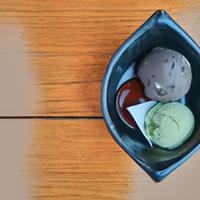
1 serving (100 grams) contains 200 calories, 3.0 grams of protein, 10.0 grams of fat, and 25.0 grams of carbohydrates.

Log this food in SnapCalorie

Nutrition Information
Calories |
476.2 | ||
|---|---|---|---|
% Daily Value* |
|||
| Total Fat | 23.8 g | 30% | |
| Saturated Fat | 14.3 g | 71% | |
| Polyunsaturated Fat | 0 g | ||
| Cholesterol | 71.4 mg | 23% | |
| Sodium | 119.0 mg | 5% | |
| Total Carbohydrates | 59.5 g | 21% | |
| Dietary Fiber | 0 g | 0% | |
| Sugars | 47.6 g | ||
| protein | 7.1 g | 14% | |
| Vitamin D | 0 mcg | 0% | |
| Calcium | 238.1 mg | 18% | |
| Iron | 0.5 mg | 2% | |
| Potassium | 357.1 mg | 7% | |
* Percent Daily Values are based on a 2,000 calorie diet. Your daily values may be higher or lower depending on your calorie needs.
Food Attributes
Source of Calories
About Japanese ice cream
Japanese ice cream, known for its delightful textures and bold flavors, is a unique twist on the traditional frozen dessert. Originating in Japan, this treat often features ingredients inspired by Japanese cuisine, such as matcha (green tea), black sesame, adzuki beans, or yuzu citrus. Made typically from milk, sugar, and cream, it may include flavorings or natural components that provide a distinctly Japanese essence. Some variations, like mochi ice cream, are wrapped in chewy rice dough, adding extra texture and enjoyment. While Japanese ice cream can be a rich source of calcium and provide an energy boost from sugars, it may also be high in calories and saturated fats depending on preparation. Traditional options sometimes embrace minimal additives, celebrating quality without excessive refinement. Offering a balance of indulgence and cultural flair, Japanese ice cream is a sophisticated and intriguing dessert for adventurous tastebuds.



